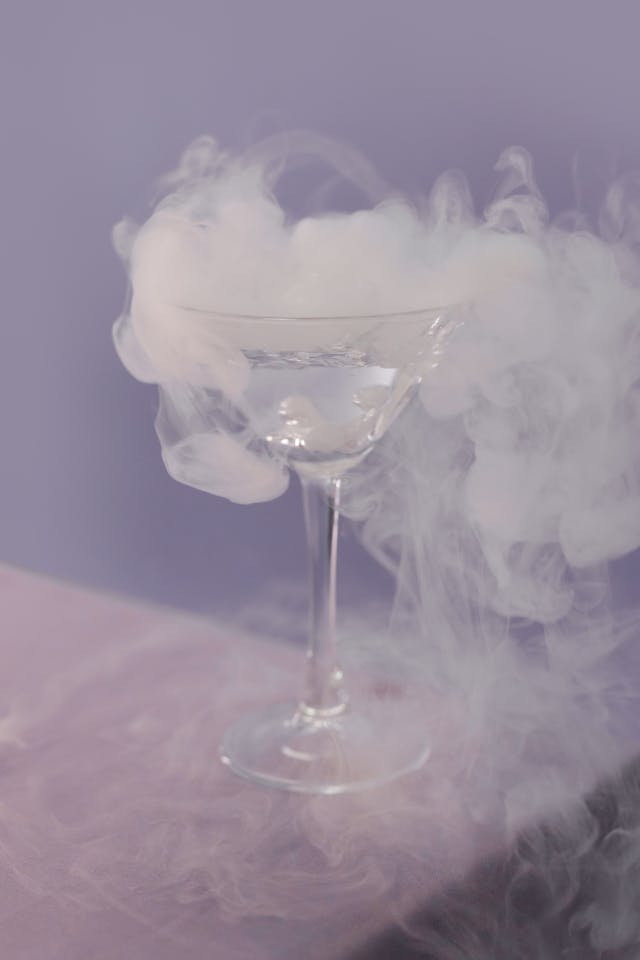
Why does dry ice fog sink? The gas from dry ice is more dense than air and therefore it sinks.
Dry ice is solid carbon dioxide. It is called dry ice because when it melts it turns into a gas rather than a liquid. Regular ice would be wet ice because when it melts it turns into a liquid. Dry ice doesn’t change into a liquid because carbon dioxide sublimates. That means it turns directly from a solid into a gas without going through a liquid phase. You can make liquid carbon dioxide, but it has to be pressurized to 5.1 times Earth’s atmosphere.
Carbon dioxide gas becomes a solid at -78.5℃. It is made by pressurizing and chilling carbon dioxide gas in a container. When the pressure is high enough, the carbon dioxide turns into a liquid. Then, the pressure is lowered rapidly and some of the liquid carbon dioxide vaporizes, which causes the temperature to plummet. The liquid carbon dioxide solidifies and forms a carbon dioxide snow. This snow is then compressed to make dry ice.
Dry ice was discovered and first produced in 1835 by a French inventor called Adrien Jean Pierre Thilorier. The process to make it was patented by Thomas B. Slate in 1924 and he started to make it commercially. His company was called the DryIce Corporation of America, which is where the name dry ice came from.
We use dry ice for many things. It is incredibly cold, so it is a great way of chilling food and keeping it cold. You may have used dry ice to keep purchases cold after you have bought them. You have probably also seen dry ice used in theaters and concerts. It produces a fog that hangs low to the ground. And this is what I want to look at.
Carbon dioxide is a solid at -78.5℃, but it starts to melt at temperatures above that. If you put a block of dry ice on your kitchen table, a white fog will come off it and sink down to the table surface. Carbon dioxide is a material that goes directly from its solid state to its gas state, and the gas coming off is carbon dioxide, but carbon dioxide is a colorless gas, so why can we see it?
The fog we can see is not carbon dioxide. It is a fog of water vapor, just like any fog we would find outside. The carbon dioxide gas coming off the dry ice is extremely cold and it chills the air around it. When the air temperature drops, water vapor suspended in the air condenses into small droplets and gets carried with the carbon dioxide, which is what makes the fog. If you want to make a lot of fog, as they do at a rock concert, you have to submerge the dry ice in warm water. The warm water naturally evaporates, making the air above it very humid. When the dry ice turns into gas, bubbles of supercold carbon dioxide escape from the water, condensing the humid air when they come into contact with it, producing a large amount of fog. The fog doesn’t last for long because the carbon dioxide warms up quickly and the water vapor evaporates into the air again.
The dry ice fog sinks to the floor because it is cold and because carbon dioxide is more dense than air. When the carbon dioxide chills the air and the water vapor condenses, it loses energy, which means the molecules don’t move as much. Density is a measure of how many molecules of something there are in a given volume and when the air molecules lose energy, they become more dense. A denser gas sinks through a less dense gas, so the carbon dioxide sinks to the floor. This is why a dry ice fog machine makes a fog that pours off the stage and clings to the floor because the dry ice sinks.
Interestingly, carbon dioxide is more dense than air so it sinks to the bottom, but we don’t have a buildup of carbon dioxide at the bottom of our atmosphere. If that happened, we would not be able to breathe and we would all die. The wind and the heat currents of our atmosphere serve to mix up all the gases, which means we don’t have heavy gases at the bottom and lighter gases at the top. If carbon dioxide is created in a container that has no source of wind, it will sink to the bottom. This is a hazard in grain silos because carbon dioxide builds up and sinks to the bottom of the silo. Workers without breathing equipment could suffocate. And this is what I learned today.
Photo by cottonbro studio: https://www.pexels.com/photo/smoke-coming-out-of-glass-5546964/
Sources
https://cryocarb.com/how-dry-ice-is-made
https://chemistry.stackexchange.com/questions/95308/why-does-the-gas-from-dry-ice-flow-down
https://en.wikipedia.org/wiki/Dry_ice
https://en.wikipedia.org/wiki/Sublimation_(phase_transition)
https://www.appstate.edu/~goodmanjm/rcoe/hwr/science/dry_ice/dry_ice.html
https://en.wikipedia.org/wiki/Liquid_carbon_dioxide
https://www.thomasnet.com/articles/other/how-is-dry-ice-made/
https://www.usgs.gov/media/images/frozen-carbon-dioxide-dry-ice-sublimates-directly-a-vapor
https://www.thoughtco.com/why-dry-ice-makes-fog-606404
